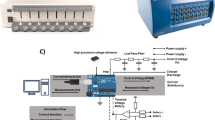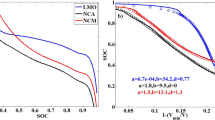Abstract
Conventions established for battery cycling were originally from the domain of chemists and material scientists interested in characterizing the battery materials. Involvement in studies with large energy storage batteries for residential energy systems outfitted with renewables demonstrated that such scenarios were very different compared to cycling regimes used for battery characterization. Transient, irregular power production and storage coupled with stochastic electrical demand result in battery usage where frequent switching between charge and discharge modes occurs. Further, energy storage control systems favor maintaining the battery in an elevated state of charge. In view of these different circumstances, experiments to characterize battery performance for a more generalized and comprehensive operating environment were developed which explored varying amplitudes of battery cycles, as well isolating a full range of instantaneous depth of discharge levels with very small amplitude cycles. To investigate the operations on a mechanistic level, numerical simulations with a pseudo-2D electrochemical model were run to discover what is occurring inside the electrodes under these conditions. It was found that localized degradation effects vary significantly across the battery capacity range, and that the net extent of degradation increased with the duration of uninterrupted charging or discharging. Analysis was performed to find a good correlation between the measured cell degradation with time-dependent transport of electrolyte phase lithium ions in the anode as a driver for SEI formation. These findings have some bearing on claims being made about pulse charging regimes under development aimed at allowing fast charging with minimal cell capacity loss penalties.
Graphic abstract















Similar content being viewed by others
Abbreviations
- \(c_{\mathrm {max}E}\) :
-
Li concentration in electrolyte phase (mol m−3)
- \(c_{\mathrm {max}S}\) :
-
Li concentration at electrode surface (mol m−3)
- \(c_{{{\text{excess}}{\kern 1pt} i}}\) :
-
Excess transported lithium-ion flux (mol m−2 s−1)
- \(C_A\) :
-
Reagent concentration in Eq. 6 (mol m−3)
- \(C_S\) :
-
Surface site concentration in Eq. 6 (mol m−2)
- C :
-
Characteristic cell current for a one-hour discharge (A)
- \(\hbox {cap}_\mathrm {fade}\) :
-
Battery cell capacity loss (A h)
- D :
-
Diffusivity constant for SEI layer (m2 s−1)
- \(D_E\) :
-
Diffusivity constant for lithium in electrolyte medium (m2 s−1)
- \(D_S\) :
-
Diffusivity constant for lithium in electrode material (m2 s−1)
- f :
-
Ionic activity factor, used here in \(\frac{d \ln f}{d \ln c_E}\) which \(\approx 0\) [29]
- F :
-
Faraday constant = 28.601 (A h mol−1)
- \(i_0\) :
-
Exchange current density for intercalation (A m−2)
- I :
-
Cell current (A)
- j :
-
Intercalation current density (A m−2)
- k :
- \(k_0\) :
-
Proportionality constant in Eq. 3 (m2 s−1)
- L :
-
SEI layer thickness (m)
- m :
-
Molecular mass of SEI material (kg mol−1)
- \(Q_D\) :
-
Rated discharge capacity of a cell (A h)
- r :
-
General surface reaction rate (mol m−3 s−1)
- R :
-
Universal gas constant = 8.3144 (J mol-1 K−1)
- R :
-
In Fig. 5 and Table 1, particle radius in electrode compact (m)
- \(S_a\) :
-
Electrode specific surface area (m2 m−3)
- t :
-
Time (s)
- \(t^{0}_{+}\) :
-
Ion transport number (–)
- T :
-
Temperature (K)
- V cell :
-
Compute cell volume (m3)
- x :
-
Spatial dimension in battery domain (m)
- \(\gamma\) :
-
Temperature factor exponent (–)
- \(\kappa\) :
-
Ionic conductivity of electrolyte (S m−1)
- \(\phi\) :
-
Electrode potential (V)
- \(\eta\) :
-
Electrode overpotential (V)
- \(\rho\) :
-
Density of SEI layer (kg m−3)
- \(\sigma\) :
-
Electrode conductivity (S m−1)
- app:
-
The external applied load for electric current
- CUR:
-
Battery current
- DOD:
-
Battery depth of discharge
- E :
-
Electrolyte phase
- REF:
-
Reference conditions
- S :
-
Solid (electrode) phase
- 1,2,-1:
-
Reaction step index in Eq. 6
References
Hesse H, Schimpe M, Kucevic D, Jossen A (2017) Lithium-ion battery storage for the grid—a review of stationary battery storage system design tailored for applications in modern power grids. Energies 10(12):2107
IEA (2018) Global EV Outlook 2018: towards cross-modal electrification. International Energy Agency, Paris, 144 pp. https://doi.org/10.1787/9789264302365-en
Blomgren GE (2017) The development and future of lithium ion batteries. J Electrochem Soc 164(1):A5019–A5025
Berecibar M, Gandiaga I, Villarreal I, Omar N, Van Mierlo J, Van den Bossche P (2016) Critical review of state of health estimation methods of Li-ion batteries for real applications. Renew Sustain Energy Rev 56:572–587
Drouilhet S, Johnson BL (1997) A battery life prediction method for hybrid power applications. In 35th aerospace sciences meeting and exhibit, Reno, NV, 6-9 Jan 11 pp
Darcovich K, Kenney B, MacNeil DD, Armstrong M (2015) Control strategies and cycling demands for Li-ion storage batteries in residential microcogeneration systems. Appl Energy 141:32–41
Ying W, Zhi Z, Botterud A, Zhang K, Qia D (2016) Stochastic coordinated operation of wind and battery energy storage system considering battery degradation. J Mod Power Syst Clean Energy 4(4):581–592
Kleiner K, Jakes P, Scharner S, Liebau V, Ehrenberg H (2016) Changes of the balancing between anode and cathode due to fatigue in commercial lithium-ion cells. J Power Sources 317:25–34
Amanor-Boadu J, Guiseppi-Elie A, Sánchez-Sinencio E (2018) The impact of pulse charging parameters on the life cycle of lithium-ion polymer batteries. Energies 11(8):2162
Zhao Y, Lu B, Song Y, Zhang J (2019) A modified pulse charging method for lithium-ion batteries by considering stress evolution, charging time and capacity utilization. Front Struct Civil Eng 13(2):294–302
Keil P, Jossen A (2016) Charging protocols for lithium-ion batteries and their impact on cycle life—an experimental study with different 18650 high-power cells. J Energy Storage 6:125–141
Josephs LC, Small EC inventors; Chargetek Inc, Potential Difference Inc, assignee (2019) Rapid battery charging. United States patent application US 10/193,366. 2019 Jan 29, 30 pp
Tkachenko O, Sherstyuk M (2018) Inventors; GBatteries Energy Canada Inc, assignee. Modulated pulse charging. United States patent application US 15/644,498. 17 pp
Darcovich K, Recoskie S, Ribberink H, Pincet F, Foissac A (2017) Effect on battery life of vehicle-to-home electric power provision under Canadian residential electrical demand. Appl Therm Eng 114:1515–1522
Dai Y, Cai L, White RE (2013) Capacity fade model for spinel \(\text{LiMn}_2\text{O}_4\) electrode. J Electrochem Soc 160(1):A182–A190
Petzl M, Kasper M, Danzer MA (2015) Lithium plating in a commercial lithium-ion battery—a low-temperature aging study. J Power Sources 275:799–807
Cheng YT, Verbrugge MW (2010) Diffusion-induced stress, interfacial charge transfer, and criteria for avoiding crack initiation of electrode particles. J Electrochem Soc 157(4):A508–A516
Smith J, Burns JC, Zhao X, Xiong D, Dahn JR (2011) A high precision coulometry study of the SEI growth in Li/graphite cells. J Electrochem Soc 158(5):A447–A452
Verma P, Maire P, Novák P (2010) A review of the features and analyses of the solid electrolyte interphase in Li-ion batteries. Electrochim Acta 55(22):6332–6341
Li Z, Huang J, Liaw BY, Metzler V, Zhang J (2014) A review of lithium deposition in lithium-ion and lithium metal secondary batteries. J Power Sources 254:168–182
Ploehn HJ, Ramadass P, White RE (2004) Solvent diffusion model for aging of lithium-ion battery cells. J Electrochem Soc 151(3):A456–A462
Pinson MB, Bazant MZ (2013) Theory of SEI formation in rechargeable batteries: capacity fade, accelerated aging and lifetime prediction. J Electrochem Soc 160(2):A243–A250
Plazinski W, Rudzinski W, Plazinska A (2009) Theoretical models of sorption kinetics including a surface reaction mechanism: a review. Adv Colloid Interface Sci 152(1–2):2–13
Recoskie S, Darcovich K, MacNeil DD J Puch (2015) State of charge functionality of capacity fade in large-scale lithium ion batteries. In: 4th International Conference on Microgeneration and Related Technologies, Tokyo, 28–30 Oct, 9 pp
Kim YC (2011) Specification Product, BatteryModel Rechargeable Lithium Ion: ICR18650 S3 2200mAh, Doc. No. LRB-PS-CY2200\_S3\_Rev8, Feb. 1, LG Chem. Seoul, Korea, p 9
Robinson JB, Darr JA, Eastwood DS, Hinds G, Lee PD, Shearing PR, Brett DJ (2014) Non-uniform temperature distribution in Li-ion batteries during discharge—a combined thermal imaging, X-ray micro-tomography and electrochemical impedance approach. J Power Sources 252:51–57
Duh YS, Tsai MT, Kao CS (2017) Characterization on the thermal runaway of commercial 18650 lithium-ion batteries used in electric vehicle. J Therm Anal Calorim 127(1):983–993
Doyle M, Newman J, Gozdz AS, Schmutz CN, Tarascon J-M (1996) Comparison of modeling predictions with experimental data from plastic lithium ion cells. J Electrochem Soc 143:1890–1903
Darcovich K, Gupta N, Davidson IJ, Caroni T (2010) Residential electrical power storage scenario simulationswith a large-scale lithium ion battery. J Appl Electrochem 40:749–755
Darcovich K, MacNeil DD, Recoskie S, Kenney B (2018) Coupled electrochemical and thermal battery models for thermal management of prismatic automotive cells. Appl Therm Eng 133:566–575
Maric T, Hopken J, Mooney K (2014) The OpenFOAM technology primer. Sourceflux Publication, Duisburg, p 455
Liaw BY, Roth EP, Jungst RG, Nagasubramanian G, Case HL, Doughty DH (2003) Correlation of Arrhenius behaviors in power and capacity fades with cell impedance and heat generation in cylindrical lithium-ion cells. J Power Sources 119:874–886
Dubarry M, Devie A (2018) A Battery durability and reliability under electric utility grid operations: representative usage aging and calendar aging. J Energy Storage 18:185–195
Randall AV, Perkins RD, Zhang X, Plett GL (2012) Controls oriented reduced order modeling of solid-electrolyte interphase layer growth. J Power Sources 209:282–288
Astaneh M, Dufo-López R, Roshandel R, Bernal-Agustin JL (2018) A novel lifetime prediction method for lithium-ion batteries in the case of stand-alone renewable energy systems. Int J Electr Power Energy Syst 103:115–126
Acknowledgements
Funding for this work was provided through the Program of Energy Research and Development (PERD) at Natural Resources Canada, and the project was commissioned by the Vehicle Propulsion Technology program of the National Research Council of Canada.
Funding
Funding was provided by PERD (Grant No. TR2-3B02.003).
Author information
Authors and Affiliations
Corresponding author
Rights and permissions
About this article
Cite this article
Darcovich, K., Recoskie, S. & Fattal, F. Fast operational mode switching effects on battery degradation. J Appl Electrochem 50, 111–124 (2020). https://doi.org/10.1007/s10800-019-01373-4
Received:
Accepted:
Published:
Issue Date:
DOI: https://doi.org/10.1007/s10800-019-01373-4




